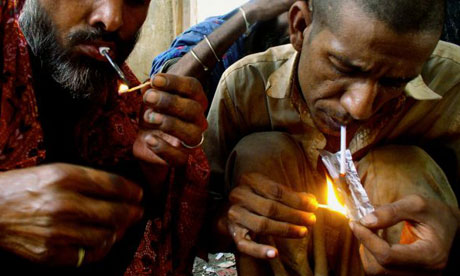Global illicit
 drug users
drug users
to rise 25% by 2050, says UN
Most of the increase expected to take place in urban populations of developing countries, but US prescription drug abuse is rising
Alan Travis, Tuesday 26 June 2012 10.00 EDT
There are about 27 million problem drug users, mainly chronic heroin or cocaine users, says the UN. Photograph: Pervez Masih
The global number of illicit drug users is likely to grow by 25% by 2050, with the bulk of the increase expected to take place among the rapidly rising urban populations of developing countries, according to the United Nations.
The UN’s office on drugs and crime (UNODC) also predicts that the biggest growth area in illicit drug use is most likely among women as cultural barriers disappear and gender equality improves.
The UN’s annual drugs report published on Tuesday forecasts a decline in the prominence of heroin and cocaine as consumption in North America and western Europe falls sharply and the “burden of the global drug problem” shifts from developed to developing countries.
In an unusual attempt to forecast future drug trends, the UN report suggests that while cannabis will remain the most widely used illegal substance, the biggest increase is likely to be seen in the use of synthetic drugs including “legal highs” and the non-medical use of prescription drugs “diverted from legal supplies”.
The annual snapshot of drug use says that around 230 million people, one in every 20, took illicit drugs at least once in 2010. There are about 27 million problem drug users, mainly chronic heroin or cocaine users, representing about 0.6% of the world’s population.
The UN says that production of opium soared by 61% in Afghanistan from 3,600 tonnes in 2010, when plant disease wiped out almost half the crop yields and triggered steep price rises, to 5,800 tonnes in 2011.
Global opium production reached 7,000 tonnes in 2011. Heroin use in North America and Europe appears to be stable or shrinking. The UN says that in Africa and Asia, which now account for 70% of heroin users,
there is a clear lack of data but it is possible there is increasing but undetected patterns of use. Burma remains the world’s second largest poppy-crop grower and opium producer after Afghanistan.
It also confirms the sharp decline in cocaine production, with an 18% drop in the total area under coca bush cultivation since 2007 with the steepest decline in Colombia. This has been accompanied by a significant fall in cocaine consumption in North America. In Europe cocaine use remains stable but continues to rival use in the US and Canada.
However, the decline in heroin and cocaine has been matched by rising levels of synthetic drugs production, including the production of “legal highs”, which are synthesised in laboratories to imitate the effects of more traditional drugs.
The UN report also confirms the rise of the non-medical use of prescription drugs, especially in Australia and the US, where their consumption is now more widespread than any other illicit substance, apart from cannabis.
In the US, deaths from misusing prescription painkillers, such as morphine, have quadrupled since 1999 and now clearly outnumber deaths involving heroin and cocaine combined. The White House has officially declared prescription drug abuse to be an epidemic and America’s fastest-growing drug problem.
The UN says its forecast that the number of illicit drug users will increase by a quarter by 2050 is in line with the growth of the world population.
“Most of these increases are likely to take place in currently developing countries. Though some ageing of the drug-using population may be expected, overall drug use is likely to continue to be primarily linked to youth.
In parallel, the large gender gap of drug use in developing countries may lead to future increases in female drug use as sociocultural barriers disappear and gender equality improves,” concludes the UN report.
“As drug use is linked to urbanisation and the urban population in developing countries is expected to double between 2011 and 2050 while remaining largely stable in the developed countries, a much more marked growth in the number of illicit drug users can be expected in the developing countries.
This suggests that a relative shift of the burden of the global drug problem from the developed countries to the currently developing countries will continue over the coming decade,” it says. Yury Fedotov,
UNODC’s executive director, said that heroin, cocaine and other drugs continued to kill around 200,000 people a year, shattering families and bringing insecurity and the spread of HIV.
“The public health aspects of prevention, treatment, rehabilitation and reintegration all have to be recognised as key elements in the global strategy to reduce drug demand,” he said.
An alternative report by the Global Commission on Drug Policy also published on Tuesday calls for drug decriminalisation and says that the “global war on drugs” is driving the HIV pandemic.
The report, endorsed by six former presidents and Richard Branson, says that drug law enforcement policies have failed to reduce the global drug supply and notes that the supply of heroin has grown by 380% in recent decades.
Click Here for guardian.co.uk/society/2012/jun/26/global-drug-users-rise-un
